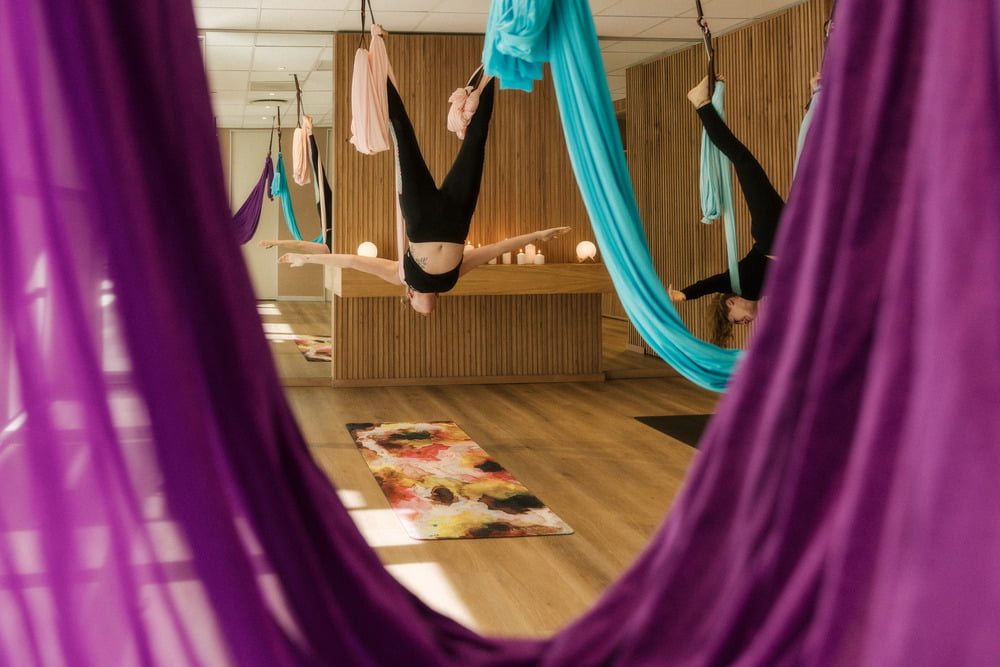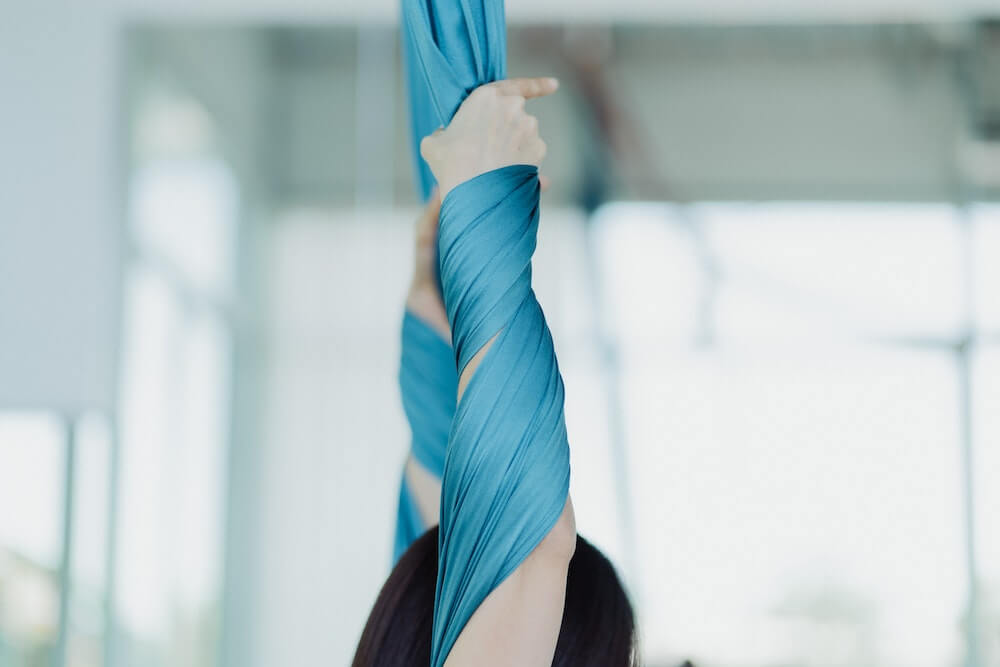Discover everything you need to know about Aerial Yoga for Beginners with our comprehensive guide for first timers.
The popularity of Aerial Yoga has grown in recent years, both in South Africa and around the world. More and more people are getting into the hammock for the first time and taking to the skies. However, the practice can seem overwhelming for beginners.
But fear not. That’s what our aerial yoga teachers are here for. We’ve guided people of all ages, sizes, genders, and levels of fitness into the hammock.
Is Aerial Yoga for Beginners?

One of the most common questions we get asked is, is aerial yoga for beginners? The answer is YES. We were all beginners once. You can’t become an expert at something if you never even start. All our aerial yoga classes are tailored to beginners unless otherwise specified. Also, there are loads of beginner aerial yoga poses.
One of the biggest things we find that stops students from trying aerial yoga is their own perception and preconceived ideas. Let those go, and try something new.
Can I Do Aerial Yoga if I’m Not Flexible?
Aerial Yoga is completely accessible to people who aren’t flexible. There are aerial yoga poses for beginners that are suited to every body and level of flexibility. There are obviously some asanas that will demand more flexibility, but there are plenty of variations that will work for bodies that aren’t as bendy.
Aerial yoga is also a great way for you to improve your flexibility and range of motion.
Is Aerial Yoga Hard for Beginners?
Honestly, it depends on you. Aerial yoga isn’t easy, but it is accessible to people of all ages and levels of experience.
The difficulty of aerial yoga depends on you. If you’ve done a lot of yoga and pilates, you may find entering an aerial hammock to be second nature. But we’ve also encountered advanced yogis who struggle to adjust to the different modality.
Everyone struggles in the first class. The first few times you get into the hammock, it’s not gonna be graceful. There’s a lot of shimmying and adjusting and awkwardness. But over time, you’ll be able to connect with the hammock more easily.
Aerial Yoga gets better (and, in a way, easier) the more you do it.
Top Tips for An Aerial Yoga Beginner

- Take things slow: Meet your body where it is, be patient with yourself. Don’t be afraid to take breaks. And keep in mind that you don’t have to follow the whole class.
- Embrace the fear: Acknowledge your fear and welcome it, then face it.
- Keep trying: If you don’t get something the first time, try again and again.
- Hold on: If you’re uncertain of anything, keep a hold of the hammock until we tell you it’s safe to let go.
- Trust your teacher: We know what we’re doing, and we want to keep you safe.
- Listen carefully: Pay specific attention to hand grips and important cues
- Watch before you move: Observe your teacher before diving in so you make sure you’re completely focussed.
- Ask for help: If you’re struggling, let us know. We want to make sure you have the best experience, and we’re here to help.
- Let go of comparison: We hold mixed-level classes, some students will fly into the hammock. They’ve been doing it for a while; don’t let it overwhelm you.
- Don’t eat a big meal at least 2 to 3 hours before the class. You can always have something small like a cereal bar to keep your blood sugar up.
- Wear the right clothes for aerial yoga: Choose form-fitting clothing that covers your legs and armpits if possible.
- Drink lots of water.
- Be gentle with inversions: Take your time with the aerial inversions, your body needs time to get used to being upside down. There are so many incredible benefits to these asanas but they do need time. Also, be sure to let your body equalize after inverted poses.
Normal Reactions to Aerial Yoga

There are a couple of things that are pretty normal when it comes to aerial yoga:
- Dizziness, nausea, and feeling light-headed are completely natural. If at any point you’re feeling dizzy, either come into a resting position in the hammock or head down onto your mat into childs pose, savasana, or advasana.
- Fear is another completely normal reaction to things like inversions, tumbles, or flips. We’ve all been there. It’s okay.
- Pressure from the hammock is something that doesn’t get spoken about too much. Sometimes, the silk will press into your body and cause discomfort. This is completely normal and does get better the more you do it.
- Bruises from the pressure are also common. You may find little colorful hammock hickeys the next day, but there’s nothing to worry about. They’ll fade pretty quickly, and your body will get used to it over time.
- You may also find your fingers and hands getting really tired, especially during your first class. We’ll show you exercises to release them. We barely use these muscles, so the first time can be intense. Just go slow and take breaks whenever you need to.
- It’s completely normal to feel overwhelmed. You’re trying a completely new thing. Remember, it’s your own practice, and you take it only as far as you can. The strength builds up over time. During my first class, I could barely pull myself up, and now it’s like second nature.
How Do I Prepare My Body for Aerial Yoga

Unless you have your own aerial hammock at home, it’s difficult to fully prepare for aerial yoga. But working on your core strength and upper arm strength will be a great help. Honestly, the best way to prepare your body for aerial yoga is by doing aerial yoga.
Traditional yoga can be useful in building strength, but you do use very different body parts during aerial. So just because you can do yoga, doesn’t mean you’ll instantly be aerial fit.
What Does a Typical Aerial Yoga Class Look Like?
Aerial yoga classes differ depending on the teacher, but in general, you can expect a class to have a beginning, main part, and ending.
This is the format of a typical 75-minute aerial yoga class:
Beginning/ Introduction:
This will last between 5 and 10 minutes. This period usually involves an introduction from the teacher, aerial yoga safety tips, and an introductory relaxation either in the hammock or on the ground.
Main Part +- 50 mins
The main part of the class lasts about 50 minutes, but this depends on the teacher and the duration of the class.
You’ll start with a warm-up that’ll last anywhere from 10 to 20 minutes.
Then, you’ll move into more intense poses and exercises. This will last between 35 and 45 minutes. Generally, this is where the inversions are introduced.
Ending
The class will typically end in the hammock with a final relaxation. This part of the aerial yoga class will last between 10 and 15 minutes. It includes savasana, grounding, gratitude, and saying goodbye. It’s also a great time for any additional questions that you might have.

Why Should Beginners Do Aerial Yoga?
Aerial yoga has so many physical benefits, it beautifully complements traditional yoga styles like hatha and vinyasa. It combines strength, flexibility, cardio and allows you to embrace fears and explore your body in an entirely new way.
For beginners, aerial yoga is an incredible experience. It also offers amazing benefits for depression and anxiety.
It’s worth mentioning that this style of yoga isn’t for everybody. But you’ll only know that once you try it out.
If you’d like to know more about Aerial Yoga, read through our ultimate Aerial Yoga Guide, or attend one of our Aerial Yoga classes.




